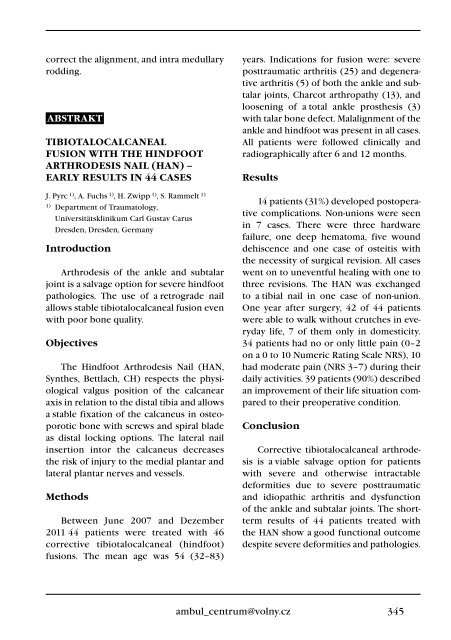3+4+Supplementum/2012 - Společnost pro pojivové tkáně
3+4+Supplementum/2012 - Společnost pro pojivové tkáně
3+4+Supplementum/2012 - Společnost pro pojivové tkáně
- TAGS
- www.pojivo.cz
Create successful ePaper yourself
Turn your PDF publications into a flip-book with our unique Google optimized e-Paper software.
correct the alignment, and intra medullary<br />
rodding.<br />
aBSTRakT<br />
TiBiOTalOCalCaneal<br />
fuSiOn wiTH THe HindfOOT<br />
aRTHROdeSiS nail (Han) –<br />
eaRlY ReSulTS in 44 CaSeS<br />
J. Pyrc 1) , A. Fuchs 1) , H. Zwipp 1) , S. Rammelt 1)<br />
1) Department of Traumatology,<br />
Universitätsklinikum Carl Gustav Carus<br />
Dresden, Dresden, Germany<br />
introduction<br />
Arthrodesis of the ankle and subtalar<br />
joint is a salvage option for severe hindfoot<br />
pathologies. The use of a retrograde nail<br />
allows stable tibiotalocalcaneal fusion even<br />
with poor bone quality.<br />
Objectives<br />
The Hindfoot Arthrodesis Nail (HAN,<br />
Synthes, Bettlach, CH) respects the physiological<br />
valgus position of the calcanear<br />
axis in relation to the distal tibia and allows<br />
a stable fixation of the calcaneus in osteoporotic<br />
bone with screws and spiral blade<br />
as distal locking options. The lateral nail<br />
insertion intor the calcaneus decreases<br />
the risk of injury to the medial plantar and<br />
lateral plantar nerves and vessels.<br />
Methods<br />
Between June 2007 and Dezember<br />
2011 44 patients were treated with 46<br />
corrective tibiotalocalcaneal (hindfoot)<br />
fusions. The mean age was 54 (32–83)<br />
ambul_centrum@volny.cz<br />
years. Indications for fusion were: severe<br />
posttraumatic arthritis (25) and degenerative<br />
arthritis (5) of both the ankle and subtalar<br />
joints, Charcot arthropathy (13), and<br />
loosening of a total ankle <strong>pro</strong>sthesis (3)<br />
with talar bone defect. Malalignment of the<br />
ankle and hindfoot was present in all cases.<br />
All patients were followed clinically and<br />
radiographically after 6 and 12 months.<br />
Results<br />
14 patients (31%) developed postoperative<br />
complications. Non-unions were seen<br />
in 7 cases. There were three hardware<br />
failure, one deep hematoma, five wound<br />
dehiscence and one case of osteitis with<br />
the necessity of surgical revision. All cases<br />
went on to uneventful healing with one to<br />
three revisions. The HAN was exchanged<br />
to a tibial nail in one case of non-union.<br />
One year after surgery, 42 of 44 patients<br />
were able to walk without crutches in everyday<br />
life, 7 of them only in domesticity.<br />
34 patients had no or only little pain (0–2<br />
on a 0 to 10 Numeric Rating Scale NRS), 10<br />
had moderate pain (NRS 3–7) during their<br />
daily activities. 39 patients (90%) described<br />
an im<strong>pro</strong>vement of their life situation compared<br />
to their preoperative condition.<br />
Conclusion<br />
Corrective tibiotalocalcaneal arthrodesis<br />
is a viable salvage option for patients<br />
with severe and otherwise intractable<br />
deformities due to severe posttraumatic<br />
and idiopathic arthritis and dysfunction<br />
of the ankle and subtalar joints. The shortterm<br />
results of 44 patients treated with<br />
the HAN show a good functional outcome<br />
despite severe deformities and pathologies.<br />
345

















